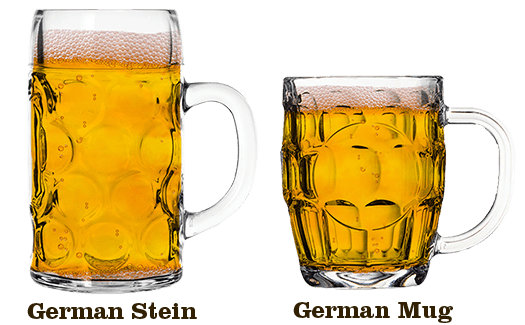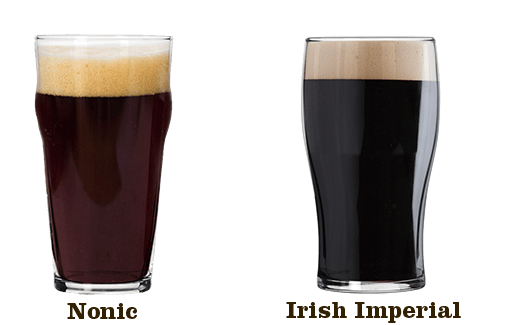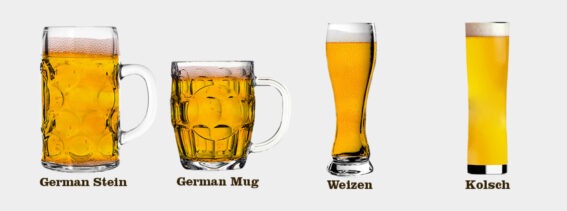There is a whole lot of talk about which glass is appropriate for serving a given style of beer and why it’s important to do so. In days of yore, drinking vessels were whatever was in reach and held liquid. These were variously tankards, flagons, pots, jacks, clay mugs, goblets, and horns just to mention a few. The drinker didn’t care as long as it was full of ale. Glassware was an expensive luxury item used by royalty and the wealthy.
The manufacture of glass had become commonplace by the end of the seventeenth century and different countries and cultures developed their own particular styles that became identified with the beers that were locally produced. There are three basic cultural or geographic points of origin that, with some overlap, provide the models for the traditional beer glassware that we use today. These are the Germanic types which also include Swiss and Austrian examples. There also Belgian types which include to some degree the Dutch and what little that can be identified as French. Finally we have the British and Irish styles.
GERMAN BEER GLASSES
There are more than a few here and we are most familiar with the classic stein. With or without the trademark pewter lid, these – more than any other drinking vessel – are identified with a particular country and a style of beer: German lager. While the classic steins are elaborate pieces, we have all seen the crockery or dimpled glass versions being clutched three or four to the fist by the Frauleins serving the masses during Oktoberfest.

Another German beer glass of note is the Weizen glass, used for serving wheat beers. It is a tall glass with the top half being larger in diameter than the bottom half. This shape accommodates a serving technique that allows for the thick head of foam associated with this style. Most of these are usually decorated with a brewery logo. Regionally, some beers like Kolsch use a smaller straight-sided glass.

BELGIAN BEER GLASSES
More than any others, the Belgians like their individual types of glassware. Some shapes were developed by the breweries to give their beer a distinct serving appearance. Others are shaped to enhance the sensory experience, or so they claim. In any case, it seems that every Belgian brewery has its own signature glassware that its beers are always served in. You can tell what someone is drinking just by the shape of the glass in their hand. There are several general styles with many variations. Very common is the goblet shape with a couple of different approaches. These have a thick stem, are one half liter, and can sometimes have a wider “chalice” mouth. Others include the flute, reminiscent of a champagne glass. The tulip and thistle glasses have a round body with a flaring mouth. Both tulips and thistles are said to enhance head retention and aromatic appreciation.

A different approach is taken by the Hoegarten brewery which has a signature glass that is a heavy octagonal tumbler, sometimes called a jelly glass for its resemblance to a jelly jar. Traditionally used for serving European wit beer but can be used for lagers as well. These come in either one half or one liter size.
BRITISH AND IRISH BEER GLASSES
While the Brits basically invented the tankard, they are best known for the pint glass. The pint is the standard serving size in England and Ireland and increasingly in America. There are a couple of minor volumetric stylistic differences between the two but nothing serious. The British glass often has a slight bulb near the top, is called a “Nonic”, and was introduced in the mid 1960’s. American pint glasses just have a tapered side and are called “shaker pints”, probably because they were originally used as martini shakers, and were adopted as beer glasses only in the 1970’s. Before that we used pilsner glasses and mugs. So much for “traditional.”
The shaker could well be the only American contribution to the current mix. I’ve heard that the British bulb is to keep the glass from slipping out of one’s hand while the tapered American glass is made thicker so that it doesn’t break as easily when dropped. Both are designed to be easy to stack. The Irish imperial pint glass has a wide mouth that tapers to a smaller base and is associated with the serving of stouts. But they don’t stack very well. The Brits also have a dimpled mug, sort of like the German glass liter, which is still used a bit and is associated with bitters. Mugs don’t stack at all which is a major reason they aren’t used much anymore. Likewise the old pilsner glasses.

OK, so now we know a little about different styles of beer glasses, but does it really matter what shape of glass your beer is served in? Well, yes and no. There two distinct sides to all this. Both have merit and both have nothing but commercial considerations.
First, shape (and size) can make a difference, especially when serving higher ABV or more unusual beers with distinct aromatic profiles. This is where the smaller size Belgian flutes, tulips, thistles, and the like come in. These are for sipping beers and are usually only six or eight ounces in size and all are stemware. The appearance, aroma, and the temperature of the beer all combine to enhance the experience. Think about Lambic or Barley wine or maybe Scotch ale here. Maybe dopplebock. Any sort of high ABV beer. Weiss bier glasses with their tall design lend themselves well to the thick head that the style is known for. They also accommodate the pouring characteristics unique to wheat beers.
As for size, you wouldn’t really want your Belgian triple to be served in an imperial pint (well, there’s always someone who might) or have your pale ale served in a six ounce snifter. Traditional shapes and sizes do have their place. But now we get to the other side of the story.
Goblet or Chalice shapes can serve a multitude of styles, usually lagers but sometimes bigger beers, and do little for the beer experience except provide commercial identification at the point of service. The various Belgian breweries will argue that their proprietary glass shapes, regardless of the subtlety of the design differences, are carefully and scientifically crafted to match and enhance their own beer. Some glasses even have small etchings on the bottom of the inside that create a narrow stream of rising bubbles which supposedly makes the beer taste better. The Hoegarten jelly glass might as well a British pint glass for all the difference it makes.
As for pint glasses, it makes no difference whatsoever as to the minutia of shape as long as the beer is somewhat appropriate to the serving size. OK, if you’re in an English pub you want to see your ale come in a Nonic pint and you want to see your stout come in an Irish imperial pint glass. Heaven forbid that you get a Guinness served in an English pint. Or worse, a dimpled mug. But that’s all subjective.
The Americans will use just about anything to get a beer across the bar. We have adopted some of the European glassware, especially the Belgian stuff when we want to be seen as beer savvy. Multi tap bars with a Belgian beer slant try to use proprietary glasses if they can get them but for the most part it’s the shaker pint over here. Guinness provides logo-ed Irish imperial pint glasses to some of the Irish bars so we do see a bit of that. Fine dining restaurants and snooty bars like to use things like the fluted pilsner or the German stang to look elegant. I think that the main reason here might be that the serving size is ten ounces or less and the price is the same or more than a bar pint.
And now, speaking of the ubiquitous shaker pint that is the standard American beer glass, I’ve got some news for you. It’s not a full pint, it’s only fourteen ounces. A full pint is sixteen ounces – or 473 ml. American pints, that is. British imperial pints are about 20% bigger at 568 ml. If your beer has a one-inch head on it, you’re only getting thirteen ounces of beer, if that. The wider the mouth of the glass, the more beer being displaced by foam. A big head on your shaker pint knocks it down to twelve ounces.
Cynical at best, but that’s business, and all this is not lost on the bar owners. It’s a marketing concept known as “perceived value”. Call it a “pint” and people believe it’s a pint, and everybody knows that a pint is much bigger than a bottle. Everything else aside, this is a big reason that shaker pint is so widely used, and that’s not the only example of deceptive glassware. With few exceptions, British-style Nonic glasses in use here in the States are not imperial pints, but rather “American pints,” or even fourteen-ouncers. The same goes for Irish stout glasses.
So then, back to the original question: Does it really matter that much?
Yes, No, and Maybe.
Yes: There are strong arguments for matching beer style with an appropriate glass. This can be for tradition as well as enhanced appreciation of unique beers served with care. Serving size can also be an important consideration.
No: I see many examples of traditional glassware that provide a vessel for serving beer and have no real purpose other than that. Unless one considers the commercial aspect of product identification by means of a proprietary glass, that is. Accordingly, the idea that your stout is going to taste better in an Irish pint or your craft beer needs to be in a shaker pint to be properly served is just plain silly. Try to imagine a glass designed to enhance your Light beer or perhaps one that makes black IPA an exotic experience. Someone’s working on it somewhere I’m sure. But it’s all marketing. A good beer tastes the same to me whether it’s served in an engraved mug or a peanut butter jar.
Maybe: Here’s where we get into the area of perceived value and possibly deceptive marketing. If you like your beer in a shaker pint and that’s the way you get it, that’s great as long as you are aware of the volume of the glass. I personally like the shaker, especially for craft beer. I know what I’m getting and don’t have a problem with it unless I feel that there is way too much head. But that’s not always deliberate and is a topic for future discussion.
Wanting ones beer in a proprietary glass for subjective reasons is, well, subjective. I guess I can go with it if it works for you. (Still think it’s silly). However (a big however) is when you think that the serving size is larger than it actually is. Subjectivity can get you into trouble here. This can often be the case when the “pint” looks like an Irish or British or whatever glass but is actually a smaller American version. Mugs with false bottoms can appear to contain more than they do. Be suspicious of any beer mug that is dimpled. The dimpling often disguises the fact that glass is extra thick towards the bottom. I’ve seen dimpled “pint” mugs that are large on the outside and hold only twelve ounces.
In my experience, the most infamous beer glass is the “schooner”. This glass was originally designed to serve ice cream and has a bowl sized mouth and a large stem which makes it look taller. It’s also made of really thick glass that gets thicker towards the bottom. The thickness is usually disguised by a row of large dimples around the bottom. All good for ice cream but a poor value for beer. Schooners typically hold little more than twelve ounces with a one-inch head even though they look like they hold a lot more. The actual volume is never mentioned. It’s just called a schooner and that is supposed to imply large serving. Fortunately, the schooner is usually only seen these days in pizza joints, sports bars, chain restaurants, and college hangouts frequented by unsophisticated consumers of American lager and light beer.
Conclusion: At the end of the day it’s all up to you. I sort of like some of the more interesting Belgian glasses and that’s a good tradition with good reasons for some of it, but I also think that the idea that any beer has to be served in its own proprietary glass isn’t important as long as it’s appropriate. I can go with tradition and culture as well but the line gets blurry here especially with the commercialized aspects of glassware design that have no impact on the beer. Just like you “can’t judge a book by its cover”, you can’t judge a beer by its glass. Go with what you like but be careful to know what you’re getting.
Written by Bob Brewer. Do you have a beer question you’d like Bob to answer? Submit your question in the comments below or post it on our Facebook page.
Boelter kindly provided the images of glassware for this blog. Check out their glassware catalog here: https://www.beercup.com/glassware

